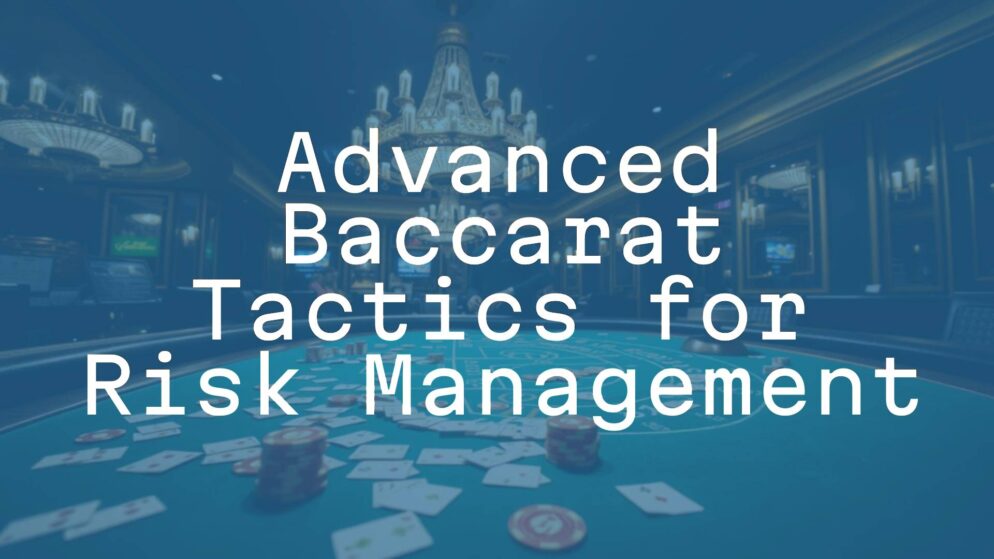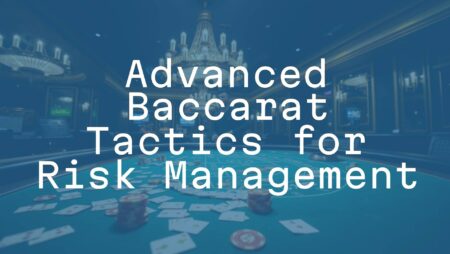

Baccarat is a classic casino game often linked with high-stakes players, and while its rules seem clear, there’s more to the game than meets the eye. Beneath its easy gameplay is a web of chance, probabilities, and risks that can catch unprepared players off guard. Baccarat mostly depends on luck, but by learning its risks and using smart tactics, players can better protect their money and potentially improve short-term results. There are no foolproof ways to win, but you can play smarter and manage your risk with the right approach.

Why Is Baccarat Risky and How Can Advanced Tactics Help?
Baccarat looks simple-just pick which side gets closest to nine. Still, the fast play, tempting side bets, and emotional highs and lows all add risk that can quickly empty your wallet. Recognizing these basic risk points is the first step in building a solid plan to protect your bankroll.
The casino’s advantage, known as the “house edge,” is always present in baccarat. This edge is low compared to many other games, but it should not be overlooked. Actively trying to limit the effect of the house edge is key to long-term success and safer play.
Main Risk Factors in Baccarat
- Fast Pace: Baccarat games move quickly, which can lead to more bets (and losses) in a short time.
- Side Bets: Bets like Dragon 7 or Panda 8 offer big prizes but come with much worse odds, increasing the risk.
- No In-Game Decisions: Unlike games like poker, baccarat doesn’t let players make choices once bets are down, which can create a false sense of safety or lead to chasing losses.

The House Edge: How It Affects Players
| Bet Type | House Edge (%) |
|---|---|
| Banker | 1.06 (after 5% commission) |
| Player | 1.24 |
| Tie (8:1 payout) | 14.36 |
| Tie (9:1 payout) | 4.85 |
The house edge is always working against you. Banker bets have the lowest edge, followed by Player. Tie is risky and rarely worth it. Understanding these differences helps you pick safer bets and keep losses low over time.
Basics of Smart Baccarat Risk Management
Managing risk in baccarat requires more than knowing the odds. Players must control both their money and emotions. Winning or losing mostly depends on how well you set money limits, stick to your plan, and avoid emotional mistakes.
- Set a budget before you start playing.
- Divide your betting money into small units.
- Don’t bet big when you’re emotional.
- Always make decisions based on logic, not streaks or gut feeling.
How to Handle Your Bankroll for Safety
- Decide upfront how much you can lose in one session. This should always be money you can afford to lose.
- Keep each individual bet small-Ideally no more than 1% of your session bankroll, and never more than 5% per bet.
Spreading your bets over many hands instead of risking it all at once helps stretch your play and soften losing streaks.
Setting Limits on Wins and Losses
- Win Limit: Decide a profit amount where you’ll stop and cash out (e.g., $100 profit on a $500 start).
- Loss Limit: Set a maximum loss (for example, stop at 50% loss of your session fund).
- Single Bet Cap: Never let one bet risk more than a set small percentage of your funds.
Having firm win and loss limits stops you from giving back winnings or digging yourself into a hole chasing lost money.

Watching Volatility During Baccarat
Baccarat results are random, but sometimes wins and losses come in streaks. Adjust your bets during streaky or unstable times. Increase bets during a good streak (but only within your betting caps) or reduce bets when things get rough. Track outcomes with a scorecard, and lower your bets (or take a break) if you notice fast changes between wins and losses.
Staying Aware of Emotions to Avoid Overbetting
- Don’t bet bigger just because you’re on a winning streak or after losing several hands.
- If you feel angry or overly excited, take a break before making your next bet.
- Discipline and self-control do more to protect you than any system can.
Bankroll Handling for Experienced Players
For those who play baccarat often, managing your betting money is an active process. It means watching your spending, shifting strategy when things change, and reacting carefully to both good and bad streaks.
Splitting Your Bankroll for Different Sessions
- Break your monthly or weekly bankroll into set amounts for each session. For example, $1,000 for the month could become ten $100 sessions.
- Never “borrow” from future sessions if you lose your current session’s funds.
This keeps losses small and controlled in each session.
Tracking Every Bet, Win, and Loss
Keeping records (paper, phone app, or spreadsheet) helps you spot betting mistakes, realize if a strategy is working, and keeps you honest about your results.
Adjusting Bets Based on What You See
- Only increase your bet size when you notice a trend – but only within your own strict betting rules.
- Reduce bets if things get unpredictable or if you’re nearing your loss limit.
- Never let bet increases become a form of chasing losses.
How to Avoid Overbetting
- Stick to your pre-set single bet size and session limits. If you’re tempted to raise your bets beyond limits, take a break.
- Don’t drink or use substances while playing – clear thinking matters.
- Each hand is independent; previous results don’t affect the next outcome.
- Set alarms or reminders to pause or end your session before fatigue leads to mistakes.
Picking the Right Bets to Cut Down Risk
With limited player decisions after the cards are dealt, your main power is in choosing where to place your bet. Advanced players focus on options with the lowest house edge to keep risk down.
Comparing the Bets: Banker, Player, Tie
| Bet | % Chance to Win | Payout | House Edge (%) |
|---|---|---|---|
| Banker | 45.8 | Even (minus 5% commission) | 1.06 |
| Player | 44.6 | Even | 1.24 |
| Tie | 9.5 | 8:1 or 9:1 | 14.36 (8:1), 4.85 (9:1) |
Banker is safest and expected to lose the least over time. Player is second place. Tie should be avoided due to its poor odds.
Payouts and House Cut
Banker’s small commission is included in its low house edge, so even though it seems like a drawback, the odds still favor it over Player or Tie bets. Tie may pay more, but the much higher house edge guarantees heavier losses long-term.
Steering Clear of High-Risk Side Bets
- Side bets pay big but odds of winning are very low. House edge on these can be 10% or more.
- Best strategy: never place side bets.

Baccarat Betting Systems for Handling Risk
Betting systems in baccarat can’t beat math, but they provide structure and routine to your wagering. This helps avoid impulsive decisions and can limit your losses or profits in certain situations.
Common Betting Systems
| System | Description | Risk Level |
|---|---|---|
| Martingale | Double bets after each loss, return to starting bet after a win. Goal: recover all losses and gain one unit profit with each win. | Very High |
| Reverse Martingale / Paroli | Double bets after each win, revert to original bet after a loss or profit goal. Aims to use “house’s money” during winning streaks. | Moderate |
| Fibonacci | Increase bets using Fibonacci sequence after losses, move back two steps after a win. | Medium |
| Labouchere | Create a series to define profit goal, sum first and last for bet size. Cross out numbers after a win, add losing bet to end of sequence if you lose. | Medium-High |
| James Bond | Fixed pattern: 70% Banker, 25% Player, 5% Tie in each round. Covers multiple outcomes but does not improve house edge. | Medium |
| 1-3-2-4 | Bet 1, then 3, then 2, then 4 units if you win each time; start over after a loss. Designed to protect profits during short winning runs. | Low-Medium |
Every system has risks and none guarantee profit. Use them for structure-not as “sure things.”
Picking the Right Baccarat Version and Table
Baccarat comes in several versions that change player experience and risk. Choosing the right one can help match the pace and stakes to your comfort and strategy.
Punto Banco vs Chemin de Fer
- Punto Banco (most common): All rules are fixed and automatic. Player skill doesn’t affect the draw. Risk management centers on how you bet and handle your funds.
- Chemin de Fer: Allows players to act as banker and make certain decisions. Very rare in North America and generally for experts only.
Mini and Online Baccarat
- Mini Baccarat: Fast pace, low minimums, more hands per hour (about 70).
- Online Baccarat: Even faster, low minimums, easy to lose track of time and spending.
Faster games mean more decisions (and risk) per hour, so bankroll discipline and taking regular breaks are more important here.
Choosing the Right Table Limits
- Your minimum bet should usually be no more than 1% of what you aim to spend that session.
- Stay away from tables where the minimum bet is too high for your bankroll.
- Watch out for table maximums if using progressive systems; they can stop you from chasing losses indefinitely (which is good and bad).
Common Baccarat Myths and Pitfalls
Successful baccarat play relies on understanding what doesn’t work as much as what does. Myths and wishful thinking can quickly raise your risk and hurt your results.
Does Card Counting Work in Baccarat?
Baccarat is not blackjack. Card counting has minor impact due to automatic rules, many decks, and frequent reshuffling. Tracking cards may offer the tiniest edge (like 0.05%), but it’s not worth the effort or casino scrutiny. Focus on solid bankroll discipline and smart betting instead.
Why Chasing Losses Is Dangerous
Trying to win back losses by making bigger and bigger bets leads to larger losses. The house edge does not change, and increasing bets after a loss is the fastest way to empty your wallet. Always accept losses calmly and stick to your loss limit. Leave when you hit it.
Gambler’s Fallacy: False Patterns and Streaks
Don’t trust patterns on scorecards to predict the next result-each hand is random. Believing “hot hands” or “changing luck” offers no real advantage and typically leads to poor decisions. Stick to your plan and avoid switching bets based on streaks you see.

Simple Practices and Helpful Tools for Safer Baccarat Play
Good baccarat play is about steady habits. Use the right tools, keep yourself in check, and track your progress to improve and stay safe.
Using Scorecards Properly
- Use scorecards to track your own betting history and session results rather than trying to spot future trends.
- They can remind you when you’re close to your set limits (for wins or losses).
Testing Strategies with Free Play or Simulations
- Practice your systems on free baccarat games online before risking real money.
- This helps you spot flaws and build confidence without risk.
Set Personal Limits and Take Breaks
- Decide in advance how long to play and stick to it.
- Take frequent breaks to keep your mind clear and avoid fatigue-driven mistakes.
- Walk away if you hit your win or loss limit, regardless of streaks.
Essential Baccarat Risk Questions
Here are answers to the most important questions about baccarat risk and strategy:
What Approach Best Reduces Losses?
- Always bet on Banker for the lowest house edge.
- Set firm money limits for each session and never exceed them.
- Keep single bets small (2-5% of your session bankroll).
- Take regular breaks to maintain focus.
Is Discipline More Important than Systems?
Yes. Having a set system is only helpful if you stick to it. Most losses come from emotional decisions, not from a specific betting system failing. Your self-control matters more than the particular method you use.
How Does Luck Differ from Long-Term Play?
In the short run, anyone can win or lose by chance. Over hundreds or thousands of hands, the house edge always leads to losses. Managing your risk means accepting you’ll sometimes lose, setting limits, and playing for fun-not trying to get lucky every time.








